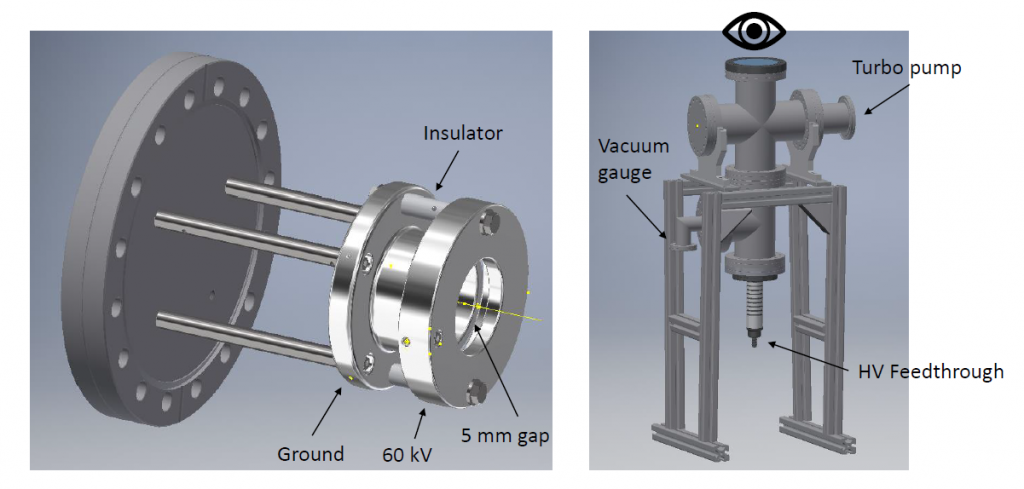High Voltage tests for mirror electrodes of a 30 keV Multi-Reflection Time-of-Flight device
Supervisor(s): Dr. Hanne Heylen, Prof. Dr. Gisela Anton
University: CERN, Friedrich-Alexander-Universität Erlangen-Nürnberg
Type: Research-oriented Project
Term(s): SS 2019
Keywoards: Experimental Project, External, High-Voltage, Nuclear Physics, Technical Physics
Abstract
The MIRACLS experiment at the ISOLDE facility at CERN seeks to overcome the sensitivity limit of conventional Collinear Laser Spectroscopy of short-lived radionuclides by extending the laser-ion interaction time by trapping ions of exotic isotopes in a Multi-Reflection Time-of-Flight device (MR-ToF). In the MR-ToF device the ions are confined between two electrostatic mirrors, which reflect the ions from side to side. The desired energy of the ion bunch is around 30 keV to achieve high-resolution laser spectroscopy data. To confine ions at 30 keV, potentials up to 60 kV have to be applied to the electrodes of the electrostatic mirrors. This presents a serious sparking risk. During this research project, a test stand for the mirror electrodes of the planned 30-keV MR-ToF device was build, and procedures to increase the voltage hold-off capability, so-called condition procedures, employed.
Experiment and results
The aim of the test stand was to establish an electrode design and conditioning procedure, that allows to apply up to 60 kV to a pair of electrodes, that will later be utilized in the ion mirrors of the MR-ToF device. Due to space constraints of the experimental set-up, imposed by the available space at the beamline, the electrodes have to be as close as 5 mm. The electrodes are manufactured from stainless steel, which is electropolished to reduce the surface roughness. The electrodes are mounted using ceramic insulators. The pair of electrodes with insulators was then mounted into a vacuum chamber with a high-voltage feedthrough to supply and monitor the voltage, as well as a window to observe possible sparks.

When applying voltage to the electrodes for the first time, a breakdown at 25 kV was observed. A breakdown is characterized by a sudden decrease in voltage and increase in current between the electrodes. After a non-destructive voltage breakdown, the voltage immediately recovers and no damage is done to the electrode. Voltage breakdowns are often accompanied by sparks, which are visible by the eye and video analysis of the sparks can be used to identify the origin of the sparks and therefore identify possible improvements of the electrode design.
At the considered vacuum pressure, electric breakdowns are usually caused by microscropic surface irregularities. At those irregularities, the applied field is greatly enhanced, electrons can tunnel out of the material. Along insulators these electrons can cause surface ionization, creating a conductive path between the two electrodes. In vacuum, electrons are accelerated across the vacuum gap and impact on the opposite electrode, which can cause damage to the surface of the electrode.
Conditioning procedures aim to improve the voltage hold-off capability by removing the microscopic surface irregularities without causing damage to the electrode. For this project, current coniditoning and spark conditioning were applied. For both procedures the voltage is increased stepwise and voltage and current are monitored. For current conditioning the voltage is increased stepwise, until electrons are emitted from the electrode, but not enough to cause a voltage breakdown. The electrons heat the site of emission causing thermal blunting. The number of emitted electrons decreases and the voltage can be increased again. For spark conditionig , controlled breakdowns are created, which also remoe sites of electron emission without causing damage. Combining those two procedures, the voltage applied to the electrodes could be increased to 42,5 kV. Furthermore the cabling of the electrodes was identified as most frequent location of breakdowns. This could then be improved for further testing.
Requirements
Basic experimental physics. Experience in programming languages and digital data acquisition is advantageous.
Further Reading
Updates about the status of the experiment and publications can be found on the website of the experiment: https://miracls.web.cern.ch/index.html